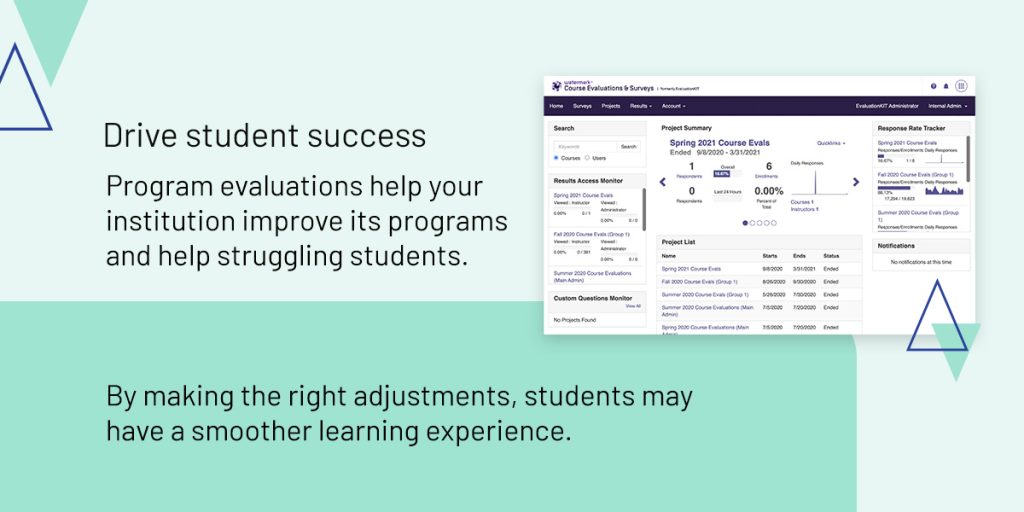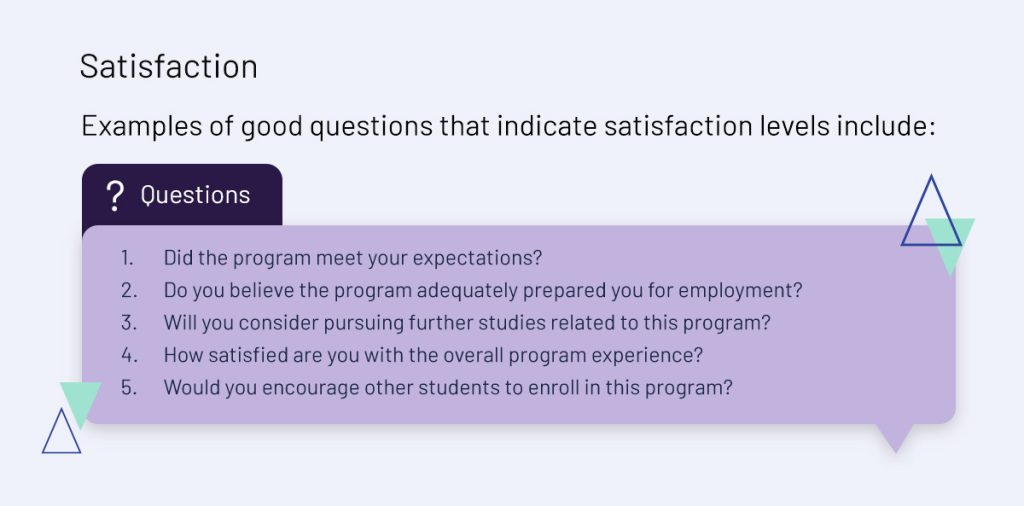




Student feedback is an invaluable resource for higher education institutions, and it’s readily available if only you ask for it. Program effectiveness surveys are one method for collecting this information. Regularly assessing student perceptions can help your institution make informed decisions and improvements to programs that help students achieve their career goals. However, the quality of your survey questions impacts the usefulness of the data you collect.
Before launching your next student survey, consider the examples of program evaluation questions for students outlined in this guide.
As the direct recipient of instruction, students have an invaluable perspective on the quality of their education. Their feedback can provide valuable insight into the program experience. Additionally, asking students for feedback makes them feel like their opinions matter, improving their engagement, academic motivation, and sense of purpose.
While most students have strong opinions about their experiences, they often lack the opportunity to share them. Program evaluation questionnaires allow students to provide their honest feedback under the protection of anonymity. With this information, your institution can:
At a higher education institution with thousands of students, it’s challenging for administrators to monitor every student continuously. Professors interact with their students throughout the week but often don’t have access to insider information. What’s more, students may feel uncomfortable revealing personal information or asking for help in person.
Surveys give students a voice, allowing you to identify struggling students who are too nervous to reach out. Some students may also only share their grievances when asked. Through surveys, you can uncover issues before they cause students to perform poorly or drop out. This strategy is even more vital for institutions with online delivery methods, as professors may have minimal interaction with students.
Measuring program effectiveness with surveys can help you create meaningful goals that significantly impact students. Because students have firsthand experience with the curriculum, they’re often the best critics of program quality. Their perspectives can highlight areas that need the most improvement. Customizing your programs to meet your student’s needs helps ensure they have the best experience and education possible.

Program evaluations help your institution improve its programs and help struggling students. By making the right adjustments, students may have a smoother learning experience and perform better academically. Consequently, your institution may see improved retention and completion rates. Student performance and satisfaction may also rise, helping you grow an institutional reputation and attract more students.
Higher education institutions often receive limited funding to cover all their expenses. Survey feedback allows your institution to identify which programs are the most important to students so they can plan their budget accordingly. It also helps administrators identify student needs for grants and other financial resources.
Thanks to the internet and social media, higher education institutions must work hard to maintain a positive public image. Students can share their opinions with a large audience, which can affect enrollment rates and institutional reputation. Listening to student feedback can help you manage potential conflict before it becomes a public issue. It also allows you to identify the key values and opinions of the student population to respond better to their concerns. Offering students real solutions to their problems shows that you listen to their feedback and value their perspective.
You can customize your program evaluation surveys to collect specific information that helps you reach your objectives. However, evaluation surveys should ideally gather information about all aspects of a program, including its curriculum, delivery methods, resources, and assessments. Use the example questions below to create a comprehensive program evaluation survey template you can use across all departments.
Programs consist of multiple courses, and each one should align and serve a clear purpose. You can better understand how effective the program curriculum is by asking:
The delivery methods your institution uses to teach the program’s curriculum will directly impact student success. Survey feedback can help your institution assess delivery effectiveness and improve student outcomes when you ask questions like:
It’s difficult to expect students to understand the program’s curriculum if they’re using outdated or inadequate resources. When writing your survey, try to gather information about what made a resource good or bad with questions like:
Program assessments highlight whether students understand the curriculum content, but the type, structure, and delivery can affect results and student satisfaction. It’s important to ask questions about how students find them, such as:
Improving student engagement and satisfaction can help you boost retention rates by keeping students interested in continuing their education. To understand student engagement within a program, ask questions like:

To gauge student satisfaction levels, ask for their opinions about the program as a whole. Examples of good questions that indicate satisfaction levels include:
Getting feedback from students in higher ed can be challenging. Your questionnaire’s length, style of questions, format, and delivery of the survey can impact the response rate and quality of feedback you receive. Try these tips to improve your program evaluation process and get more responses:
Asking students to complete an optional survey on their own time will likely have unsuccessful results. Most students may forget or choose not to do it. Giving students time to complete the survey in class can yield a much higher response rate, and most students are happy to take a break to answer a few questions.
It only takes 10-15 minutes away from class to collect information that can significantly impact the success of your curriculum in the future.
Students are more likely to provide feedback when they feel like their opinions matter. In the weeks leading up to the survey, explain the importance of their input and how you will use it to make improvements. You could also share examples of how program evaluations have made a difference in the past.
To improve your response rates, give students an incentive to complete the questionnaire. Offering bonus points is an easy way to increase participation significantly. Setting a target response rate for the entire class may encourage an even higher response rate. For example, you can give bonus points if the class reaches 80 percent completion. That way, students will encourage their peers to finish the survey so everyone can receive the reward.
In case students missed your discussion on the importance of student feedback, be sure to include the purpose of program evaluations and the value of their responses at the top of your questionnaire. Explain how their feedback will help other students, faculty, and the institution overall.
A program effectiveness survey aims to collect actionable feedback you can use to make improvements. Asking specific questions yields helpful information you can use to achieve this goal. Ensure each question is easy to intercept and only asks about one thing for the best results.
Closed-ended questions have a preselected bank of answers, like multiple-choice or true-false questions. Open-ended questions allow the respondent to write their own feedback. While closed-ended questions make it easy to compare large volumes of data, open-ended questions collect detailed insights and opinions from your students. Using a mix of both can help you collect comprehensive feedback in one short, simple survey.
The Likert Scale is a format for scaling survey questions to determine the respondent’s attitudes, values, opinions, behaviors, or experiences. A Likert scale question starts with a statement, followed by a five- or seven-point ordered scale of potential answers. You can frame a Likert scale with various response options to measure levels of agreement, importance, satisfaction, difficulty, and many other perspectives.
For example, if you’re using a five-point Likert scale to measure levels of agreement, the question answers would appear like this:
Framing your program evaluation questions with the Likert scale allows students to provide a more detailed response than having only two options. It also helps reduce measurement errors when respondents must choose from the available answers, even if they disagree with all of them. Likert scales allow for degrees of opinion, resulting in more accurate data that’s easy to analyze and understand.
Leading questions use biased language that may cause students to answer in a certain way that may not reflect their genuine opinion. These questions often sway the respondent to provide feedback that aligns with the goals of the survey creator. Leading questions will skew your results and negatively impact the accuracy of your data.
It’s crucial to phrase your questions with neutral language to elicit honest and valuable feedback. For example, instead of asking, “How much did you enjoy this course?” you could ask respondents to rate their satisfaction with the course using a Likert scale.
Demographic questions can be valuable in some circumstances. However, when it comes to student surveys, it’s best to ask as few as possible. People value their privacy and confidentiality and have become increasingly hesitant to reveal personal information. Demographic questions may stop students from completing course evaluations, fearing their responses will reveal their identity. Accordingly, remove any irrelevant demographic questions from your survey.
When creating a program effectiveness survey questionnaire, make sure it doesn’t get too long. Surveys that are longer than 10-15 minutes may overwhelm your respondents and could degrade the quality of their answers. Choose the most important questions that provide feedback for your key goal areas. Shorter surveys tend to have higher completion rates and higher-quality feedback.
Once you’ve successfully collected student feedback, it’s time to take action. Your higher education institutions can utilize survey data to:
Using digital course evaluation software to streamline the survey process can help you save time and money. With Watermark, you can create, deliver, and analyze program evaluation surveys with one comprehensive program.
Our Course Evaluations & Surveys solution allows students to provide valuable feedback from their computer or mobile devices in real time. The program combines hundreds of surveys into one centralized report that instructors can access immediately. Plus, our software integrates seamlessly with your existing learning management systems without disrupting current operations.
Take advantage of student feedback in an organized and streamlined way with Watermark. Request a demo today to experience our convenient solutions for yourself!





























































































































































































































































































































































































